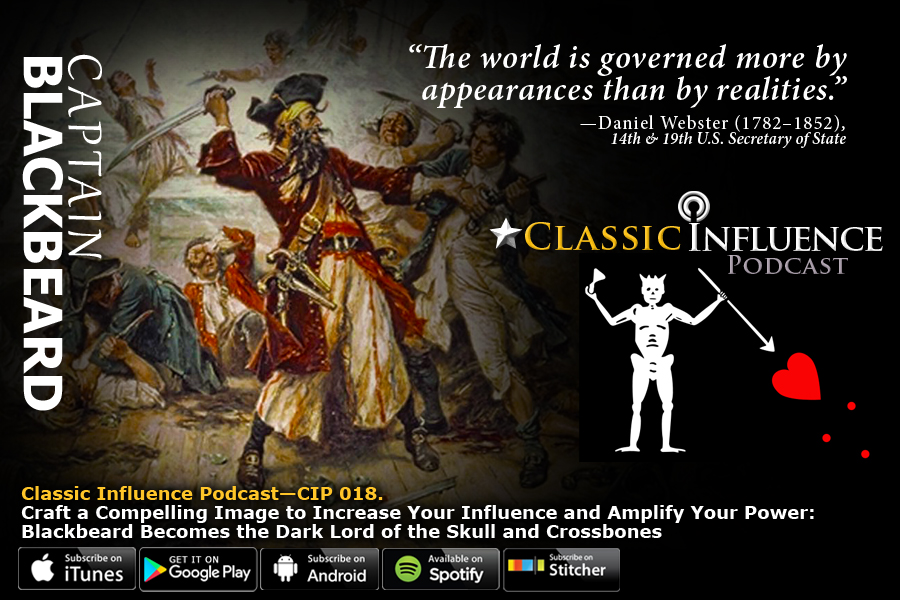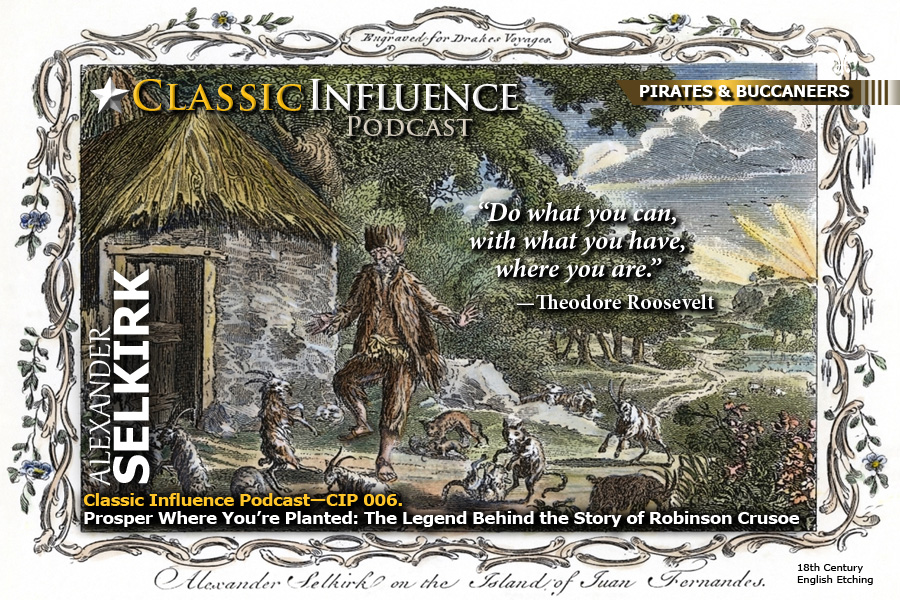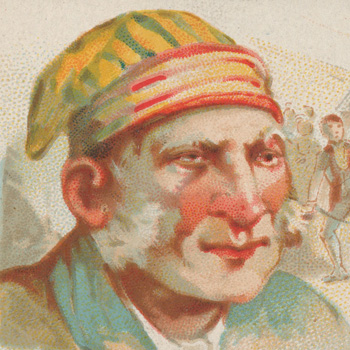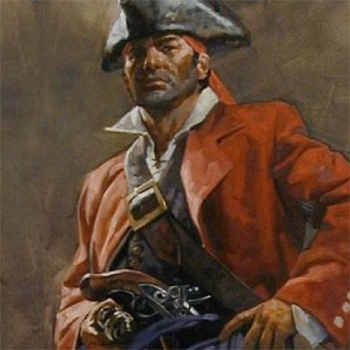The Ultimate List of Famous Pirates, Raiders, and Buccaneers:
Strategy, Power and Influence of History's Most Infamous Maritime Marauders
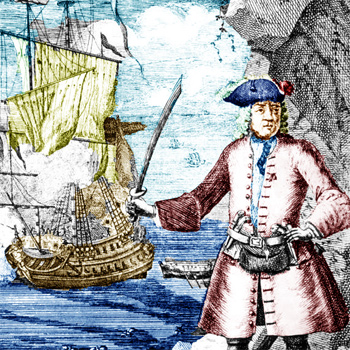
Henry Every
Years Active: 3 Years
Most Notable Event: Successful raid on a 25-ship convoy of Grand Mughal vessels making their annual pilgrimage to Mecca, which included the treasure-laden Ganj-i-Sawai (a large, armed trading ship owned by the emperor of India.
Henry Every (1659—1696)
Alexander Selkirk (1676—1721)
Scottish buccaneer and navigator Alexander Selkirk’s experience as a castaway on an uninhabited island off the coast of Chile is the inspiration behind the legend of Robinson Crusoe. Robinson Crusoe is a novel written by Daniel Defoe and first published in April 1719. Selkirk’s story begins in September of 1704 when he was the sailing master (the naval officer responsible for navigation) of the Cinque Ports on a privateering expedition in the South Pacific. When his ship was infested with worms, which reduced parts of the hull to near pulp, Selkirk began to doubt the vessel was seaworthy. With the tyrannical Captain Stradling refusing to stop for repairs, Selkirk demanded that he be dropped off at the nearest island. Already tired of quarrelling about their location with Selkirk, the Captain immediately agreed. When Selkirk, after being dropped off in the surf, first reached the hot sand on the shore and set his few possessions on the beach, he began to have second thoughts. But it was too late, he suddenly turned around in a panic only to watch the ship and its crew sailing away toward the horizon. Selkirk hoped it wouldn’t be too long before another ship would pass by and he would be rescued. Not wanting to overlook any possibility of rescue, he spent the bulk of his days scanning the horizon hoping to spy a passing ship.
Learn more about Alexander Selkirk’s incredible experience as a castaway in Classic Influence Podcast (CIP) episode #006: Prosper Where You’re Planted: The Legend Behind the Story of Robinson Crusoe
Woodes Rogers
Country of Origin: England.
Years Active: 1709—1710.
Most Notable Event: Sailing around the world, serving as governor, and suppressing the activity of the pirates in the Caribbean.
Woodes Rogers (1679—1732)
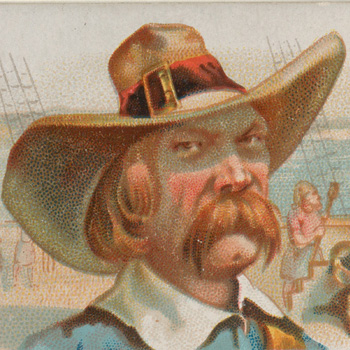
Charles Vane
Years Active: 1716—1721
Most Notable Event: Taking a stand against England’s Governor of Nassau, Woodes Rogers.
Charles Vane (1680—1721)
Charles Vane was known for his cruelty and lack of respect for the pirate code. He often beat, tortured, and murdered his captives. Vane operated out of the Bahamas toward the end of the Golden Age of Piracy. Born in England, Charles Vane began his career as a pirate off the coast of Florida under the leadership of Henry Jennings during his attack on the salvage crew of the wrecked Spanish Treasure Fleet of 1715. For a time, Charles Vane worked together with another famous pirate known as Jack Rackham or “Calico Jack.”
Edward Teach "Blackbeard" (1680—1718)
Captain of Queen Anne’s Revenge, Edward Teach (or Thatch) was an English pirate who operated around the West Indies and the east coast of North America.
John "Calico Jack" Rackham (1682—1720)
Samuel "Black Sam" Bellamy (1689—1717)
“Black Sam” Bellamy started out as an impoverished colonist living in America, who turned to piracy to make a living and support a family. Fed up with British oppression, Bellamy was considered the Robin Hood of pirates. He stole from wealthy British merchants to give to the poor. He was also dubbed “Sam the Good,” for he freed slaves and rules his fleet democratically.
Capturing some 53 ships in little more than a year, history also reports “Black Sam” Bellamy as the wealthiest pirate in the entire Golden Age of Piracy. Lashing out against the corrupt elites of England, who robbed the poor under the cover of the law, Bellamy famously said:
“I am a free prince, and I have as much authority to make war on the whole world as he who has a hundred sail of ships at sea and an army of 100,000 men in the field; and this my conscience tells me! But there is no arguing with such snivelling puppies, who allow superiors to kick them about deck at pleasure.”
Pirate or Privateer? Corsair, Sea Dog, or Buccaneer? What’s the Difference?
- Pirates: Illegal criminals who attack any vessel or village. Some pirates remained loyal to their home country. Pirates have also been known as sea-rovers or freebooters.
- Privateers: Legally commissioned to attack enemy vessels or villages. In practice, privateers were not very different from pirates. The big distinction was that they operated with a thin veneer of legitimacy in that they were commissioned by a government to attack foreign ships or raid foreign settlements. Nevertheless, they were still primarily about stealing wealth as opposed to eliminating enemy combatants in war. Privateers usually possessed a “letter of marque” papers issued by their government granting them permission to attack enemy merchant ships and take their goods by force.
- Sea Dogs—Sea Dogs was a term used by Elizabeth I of England to refer to her supplementary navy. Sea Dogs were English privateers who attacked French ships around England and the Spanish Main. Famous Sea Dogs include Sir Martin Frobisher and Sir Richard Hawkins.
- Dunkirkers—Privateers or commerce raiders working for the Spanish monarchy.
- Grey Area:
- Buccaneers: Buccaneer was the term originally applied to hunters who earned their living by selling meat to passing Spanish ships, (term comes from the French word “boucan” which was used to smoke meat). When these hunters later turned to piracy the term buccaneer evolved to mean pirate, but was still generally applied to those pirates (and privateers) who operated in the Caribbean Sea, particularly around Tortuga, Jamaica, and Hispaniola (the island which today includes the nations of Haiti and the Dominican Republic)
- Corsairs—Also known as Barbary Pirates or Tripoli Pirates,corsairs were pirates or privateers who operated in the Mediterranean Sea or off the Barbary Coast of North Africa. Corsairs were often Muslim privateers authorized by governments in the Ottoman empire, including near major ports such as Tripoli, Tunis, and Algiers.
List of Famous Pirates, Raiders, and Buccaneers:
- Awilda—Believed to be the daughter of a 5th century Scandinavian king, Awilda, according to legend, was betrothed to a prince against her will. In order to escape the unwanted marriage, Awilda disguised herself as a man and joined a crew of pirates. As a member of the pirate crew, Awilda proved to be a skilled strategist and a fearless fighter. She swiftly rose through the ranks until she became the captain of her own pirate ship. She eventually commanded an entire fleet of ships that terrorized the coasts of the Baltic Sea. While some historians question whether she was a real historical figure, the legend of Awilda has been the subject of many stories, songs, and poems over the centuries, and her exploits have been romanticized in popular culture. The earliest known reference to her appears in the medieval Danish ballad “Awilda’s Death,” which dates back to the 16th century.
- Sayyida al Hurra (1485—1561)—known as “The Pirate Queen of the Western Mediterranean”
- Grace O’Malley (c. 1530—1603)—Grace O’Malley, also known as Gráinne Mhaol or Granuaile, was a legendary Irish pirate queen who lived during the 16th century. She was born around 1530 in County Mayo, Ireland, and became an influential figure in Irish history and folklore. Grace O’Malley hailed from a seafaring family and inherited her father’s shipping and trading business. Along with her abilities as a leader, Grace O’Malley was known for her exceptional maritime skills, both as a captain and as a warrior. She commanded a fleet of ships and controlled the waters off the western coast of Ireland. Something of a political strategist, O’Malley’s exploits were not confined to piracy alone; she was also involved in politics and resistance against English rule in Ireland. She actively fought against English forces and defended the independence of her clan and territory. One notable event in Grace O’Malley’s life was her meeting with Queen Elizabeth I of England in 1593. Legend has it that she sailed to England and requested a private audience with the queen. The meeting reportedly took place, and while details of their conversation are unclear, O’Malley is said to have secured favorable terms for herself and her family. Grace O’Malley’s legacy as a pirate queen and a symbol of Irish resistance has endured through the centuries. Her fearlessness, leadership, and determination have made her a beloved figure in Irish history and folklore. Today, she is remembered as a powerful symbol of Irish identity and a legendary figure in the annals of piracy.
- Henry Strangways (circa 1530—1562)—Born in Dorset, England, Henry Strangways was an English pirate who operated in the Caribbean and along the North American coast during the mid-17th century. He was one of the earliest recorded pirates in the Americas. He was considered a “Gentleman Pirate” given his upbringing in a well-known family of good standing and his humane treatment of prisoners. He began his pirate career plying for plunder in the Irish Sea, but later focused on attacking Spanish ships. He was repeatedly imprisoned, and pardoned by highly placed friends, including a pardon from Queen Elizabeth I (which some historians use to suggest he was more of a privateer) during his approximately eight-year piratical career, from approaximately 1552 to 1560
- Sir Francis Drake (c. 1540—January 28, 1596)—Sir Francis Drake was an English explorer, privateer, naval officer, and politician. Born in Devon, England in 1540, Drake began his career as a sailor and privateer. He gained notable experience in voyages to Africa and the Caribbean. In 1580, after a three year long expedition, Drake became the first Englishman to sail around the world, a journey filled with peril and adventure; including strange encounters with indigenous peoples and battles against Spanish ships on the high seas. Returning with rich cargo, treasure, and spices for his queen, Elizabeth rewarded Drake with a knighthood for his successful circumnavigation. Sir Francis Drake was also well known for his audacious attacks on Spanish treasure ships and his ruthless raids against Spanish colonies in the Caribbean. While Drake possessed a letter of marque from England, giving him a veneer of legitimacy as a privateer, his skillful capturing of Spanish ships and his pitiless plundering of Spanish ports ensured that the Spanish Empire considered him nothing more than a bloody and brutal pirate. Drake’s greatest military achievement occurred in 1588 during the conflict between England and Spain. As vice admiral of the English fleet, he played a crucial role in the defeat of the Spanish Armada, a formidable naval force that had been sent to invade England. Drake was hailed as a hero throughout England. Along with his considerable naval accomplishments, Drake was also involved in English politics. He served as a Member of Parliament from 1624 to 1629. He also briefly held the position of Mayor of Plymouth. Today, Sir Francis Drake is remembered as a daring explorer, a naval commander, and a national hero. An icon of English naval power, Drake’s circumnavigation of the globe and his victories against the Spanish Empire ensured his place in history as one of the most prominent figures of the Elizabethan Age.
- Peter Easton (c. 1570—1620)—Known as Peter “the Pirate,” Easton was a notorious English pirate who operated primarily in the Atlantic Ocean, particularly in the waters around Newfoundland, Canada, and the West Indies. Born in England in the late 16th century, Easton began his career as a privateer, but eventually turned to piracy, becoming one of the most feared pirates and successful maritime strategists of his day. During the early 1600s, Easton commanded an entire fleet of pirate ships, which included heavily armed vessels and large crews. He captured numerous ships, including merchant vessels, amassing a considerable fortune. Setting up a safe haven in Newfoundland, a base of operations to make repairs and resupply, Easton also showed himself to be a clever strategist who had a network of allies and informants in the region. This allowed him to gather intelligence and maintain a measure of control over his territories. One of the most notable incidents associated with Peter Easton was his capture of the Spanish treasure ship Santa Teresa in 1612. The captured treasure was believed to be of immense value, further building Easton’s wealth and reputation as a successful pirate leader. Despite his piratical activities, Easton was known for his relatively lenient treatment of prisoners and the local populations. He was seen by some as a folk hero, particularly in Newfoundland, where he was admired for his strategic defiance of Spanish and Portuguese dominance in the region. In 1614, under pressure from various governments and private interests, Easton agreed to accept a pardon from the English crown. He retired from piracy and disappeared from historical records. Peter Easton’s exploits and his dominance in the waters around Newfoundland have made him one of the most famous and influential pirates of the early 17th century. His legacy continues to be remembered in pirate lore and the history of piracy in the Atlantic.
- Roche Braziliano (circa 1630—1671)—A Dutch pirate of Portuguese descent who operated in the Caribbean during the late 17th century. He was known for his raids on Spanish and Portuguese ships. He was first made famous in Alexandre Exquemelin’s 1678 book The Buccaneers of America. He was known for his cruelty and for later sailing in company with Sir Henry Morgan.
- Sir Henry Morgan (1635—1688)—Captain Henry Morgan was a Welsh privateer who gained significant fame and fortune during the late 17th century. He is best known for his exploits in the Caribbean and his association with the buccaneers. Morgan was born in Wales, but later moved to the English colonies in the Caribbean. He started his career as a privateer. However, Morgan’s activities blurred the lines between piracy and privateering, and his actions were oftentimes controversial. Morgan became known for his daring raids on the Spanish colonies, particularly possessions in the Caribbean. A master strategist and tactician, one of his most famous piratical feats was the raid on Panama City in 1671. With a fleet of privateer ships, Morgan attacked and captured the city, leading to widespread looting and destruction. The raid on Panama made Morgan exceptionally wealthy. It also led to him becoming a national hero in England. He was later knighted by King Charles II for his daring exploits. Toward the end of his life he was appointed as Lieutenant Governor of Jamaica. The legacy of the celebrated Captain Henry Morgan is not without controversy, however. While he was celebrated as a hero in England, he was also accused of being brutal and ruthless in his actions. Nevertheless, forever linked with piracy and adventure, Captain Morgan remains a prominent figure in Caribbean pirate lore.
- Captain William Kidd (c. 1645—May 23, 1701)—Captain William Kidd is one of history’s most infamous pirates. He was born in Scotland and began his career as a privateer authorized by the British government to seize enemy French ships during the Nine Years’ War. In 1696, Kidd set sail on the Adventure Galley intending to capture pirates and enemy ships in the Indian Ocean. But over time, his actions became increasingly questionable and he eventually turned to piracy himself. Kidd’s reputation as a ruthless pirate grew and he became a target of the British authorities. In 1699, the Royal Navy captured him and transported him to England to stand trial for piracy and murder. Kidd’s highly publicized trial ended in his conviction for piracy and the murder of one of his crew members. He was hanged in London in 1701. Kidd’s story has captured people’s imaginations, fueling legends of hidden treasure. Some historians argue Kidd may have been unfairly labeled a pirate by the British government and was more of a privateer whose deeds were exaggerated. Nevertheless, Captain Kidd remains a well-known figure in pirate lore, mentioned often in popular culture as one of the most notorious pirates of the Golden Age of Piracy.
- Cotton Mather (1663—1728)—a New England clergyman, Cotton Mather was a fierce and outspoken anti-pirate. He is also famous for his participation in the Salem Witch Trials.
- Bartholomew “Black Bart” Roberts (May 17, 1682—February 10, 1722)—Black Bart (real name Bartholomew Roberts) was a feared Welsh pirate active in the early 1700s. Little is known of his early life. In 1719, he joined Howell Davis’ pirate crew. After Davis’ death, the crew elected Roberts as their new captain. Roberts ran a disciplined ship under a strict Pirate Code that regulated plunder division, prisoner treatment and crew conduct. His fair leadership earned him crew loyalty and a reputation as a just captain. Roberts and his men raided numerous European ships in the Atlantic and Caribbean , looting valuable cargo and capturing vessels to amass great wealth. One famous exploit was capturing the Portuguese slave ship “Nostra Senhora do Cabo”. Roberts re-armed her as the “Royal Fortune” and continued pirating with great success. In February 1722 off West Africa, the Royal Fortune was attacked by the British warship HMS Swallow. During the battle, Roberts was killed by grapeshot and his crew captured. Black Bart’s legacy lies in his remarkable success, disciplined crew and adherence to the Pirate Code. He is remembered as one of the most accomplished pirates of the Golden Age of Piracy.
- John “Calico Jack” Rackham (1682—1720)—Calico Jack got his start as a pirate in 1718 working as quartermaster on Charles Vane’s brigantine Ranger . Rackham primarily operated out of the pirate base on New Providence island in the Bahamas, famously known as “The Pirate Republic.”
- William Moody (Died in 1719)—William Moody was a brutal British pirate active in the Caribbean and off North America during the Golden Age of Piracy. Moody began as a privateer authorized by England to attack enemy ships, but like many privateers he turned to piracy after peace treaties. Moody commanded the pirate ship Rising Sun, known for its black hull and red sails. His crew attacked many merchant ships in the Caribbean, gaining a reputation for their violent and torturous tactics. In 1715, Moody and his crew salvaged treasure from Spanish shipwrecks off Florida, including gold, silver and other valuables. In 1718, a hurricane off Cuba severely damaged Moody’s ship and killed many of his crew. He and the survivors were stranded on an island and faced capture by the Spanish. Moody managed to escape but the details of his subsequent fate are uncertain. Though his pirate career was short-lived, Moody’s reputation for daring and brutality earned him a place in pirate folklore as an emblematic figure of the Golden Age of Piracy.
- Mary Read (1685—1721)—one of the few female pirates in recorded history. Born in England, Mary dressed in men’s clothes and went by the name Mark so that she could become a pirate. She joined the crew of Jack Rackham, along with Anne Bonny, another female pirate and the partner of Rackham.
- Edward England (c. 1685—1721)—Edward England, whose real name was probably Edward Seegar, was a pirate who operated in the late 17th and early 18th centuries. He was born in Ireland around 1685, though the exact date of his birth and death are uncertain. Edward England is believed to have started his pirate career around 1717 when he joined the crew of the pirate captain Christopher Condent. England eventually rose through the ranks and became the captain of his own pirate ship. One of the notable incidents associated with Edward England was his capture of the ship Cassandra in 1719. After capturing the vessel, he decided to keep it as his flagship and renamed it the Royal James. England and his crew sailed in the Indian Ocean, targeting ships belonging to the East India Company and other European traders. England was known for being relatively lenient and fair to the crews of the ships he captured, earning him a reputation as a so called “gentleman pirate.” He was said to treat prisoners with decency and was known for his sense of style, often dressing in fine clothes and jewelry. However, England’s piratical career was relatively short. In 1720, while sailing off the coast of Madagascar, his ship, the Royal James, ran aground on a sandbar and became stranded. The crew abandoned the ship and took a smaller vessel, but England and some of his men were captured by a passing ship. After his capture, Edward England and his crew were taken to the island of Réunion (known as Bourbon Island), where they faced trial and were convicted of piracy. England was later pardoned by the French authorities and disappeared from the historical record.
- Stede Bonnet (1688—1718)—known as “The Gentleman Pirate,” Bonnet was born in Barbados to a wealthy English family.
- Edward Low (1690—1724)—Edward Low (1690 – 1724), Edward “Ned” Low, was an infamous English pirate who terrorized the Caribbean and American eastern seaboard in the early 18th century. He earned his sinister reputation through the ruthless brutality he exhibited toward his victims.Sir Arthur Conan Doyle once described Low as “savage and desperate,” and a man of “amazing and grotesque brutality.” (Doyle, 1900, The Green Flag) Possessing an enormous, brawny physique and a long black beard, Low struck fear into the hearts of sailors throughout the region.Low began as a member of Captain George Lowther’s pirate crew but soon formed his own band of marauders. His attacks were relentless and savage; he frequently sank merchant ships and executed all survivors. In one brutal episode, Low tortured several captured sailors for hours, mutilating body parts to coerce them into revealing where their vessels were hiding valuables. Despite his fearsome notoriety, Low’s pirating days were cut short when he was captured by the Royal Navy in 1724 and hanged in Boston. However, his legacy as one of history’s most bloodthirsty pirates lives on through pirate folklore and popular culture.
- Howell Davis (also “Hywel Davies”(1690—1719)—operated out of New Providence and Coxon’s Hole in Honduras. Davis was known for his intelligence, and he often used tricks and stratagems instead of relying only on firepower and fear.
- Anne Bonny (1697—1721)—one of the few female pirates during the Golden Age of Piracy, Anne Bonny was born in Ireland and operated throughout the Caribbean. She was the partner and lover of Calico Jack Rackham. Most of what is known about Anne Bonny and many other pirates of this period comes from Charles Johnson’s A General History of the Robberies and Murders of the most Notorious Pyrates (1724)
- Paulsgrave Williams— a pirate who was active 1716–1723 and sailed in the Caribbean, along the American eastern seaboard, as well as off the coast of West Africa. He is best known for sailing with Samuel Bellamy. While not as widely known as some of the more famous pirates of his time, he had an eventful and colorful career.
- Captain Henry Jennings (Died circa 1745)—Captain Henry Jennings was an English privateer turned pirate who operated during the late 17th and early 18th centuries. He was active in the Caribbean and played an influential role in the era known as the Golden Age of Piracy. Jennings began his career as a privateer, a legally sanctioned pirate authorized by governments to attack and plunder enemy ships during times of war. He operated with a privateering commission during the War of the Spanish Succession, targeting Spanish vessels and settlements in the Caribbean. However, after the war ended in 1713, Jennings and many other privateers found themselves without legal employment. Frustrated by the lack of opportunities, he turned to piracy and became one of the most notorious pirates of the era. Jennings is particularly known for his involvement in the pirate republic of Nassau in the Bahamas. Around 1715, he and other pirates, including Blackbeard, Henry Avery and Benjamin Hornigold, took control of Nassau and established it as a base for piracy. They operated under the famous “Pirate Code” and established a self-governing system. Under Jennings’ strategic leadership, the pirates of Nassau launched several successful raids on merchant ships amassing substantial wealth. They disrupted trade routes and caused significant economic losses to European powers in the region, including the slave trade. One notable incident associated with Henry Jennings was the raid on the Spanish town of Tampico in present-day Mexico in 1717. Jennings and his crew captured the town, looted it, and held the inhabitants for ransom. Despite his success, Jennings’ piratical career was short-lived. In 1718, the British government launched a campaign to suppress piracy in the Bahamas. Many pirates, including Jennings, accepted the King’s Pardon and retired from piracy. The exact details of Jennings’ later life and fate are unclear. Captain Henry Jennings played a significant role in the history of piracy during the Golden Age of Piracy, particularly given his leadership in the Pirate Republic at Nassau. His activities as a privateer and pirate contributed to the legends and lore surrounding this era.
- Emanuel Wynn—Emanuel Wynn, believed to be the first pirate to fly the Jolly Roger, was an infamous Caribbean pirate active during the Golden Age of Piracy. Little is known about Wynn’s early life, though he is thought to have been born in Wales or England. He terrorized the Caribbean and American coast between 1717 and 1720 when piracy was at its peak. Wynn wore distinctive clothing, including colorful clothes and a turban, earning him the nickname “The Turk.” He commanded a pirate ship targeting merchant vessels in the Caribbean. Wynn was also known for his aggression and cruelty, showing little mercy to captured crews. One notable incident was Wynn’s seizure of the British ship Katherine in 1717. His crew reportedly tortured and brutalized the sailors before looting the ship. Wynn’s piratical career was brief, and the circumstances of his death around 1720 remain a mystery. Though many details of his life are unclear, Wynn’s fearsome reputation has secured his place in pirate lore as an iconic pirate of the Golden Age.
- Witch of Eastham—lover of Sam Bellamy
- Black Caesar—Black Caesar was a former slave who later became a part of Blackbeard’s crew. He quickly rose to become one of Blackbeard’s lieutenants. He later became a pirate captain in his own right, operating off the Florida Keys. Today, there is a small island in Biscayne National Park in south Florida named after Black Caesar. It’s called Black Caesar’s Rock or just Caesar’s Rock and it is in the middle of Caesar Creek which is also named after Black Caesar.
- Christopher Condent (circa early 1700s)—Christopher Condent was an English pirate who operated during the early 18th century. Condent is known for his piratical activities in the Caribbean and along the eastern coast of North America. He was active during the “Golden Age of Piracy,” a period when piracy was prevalent in the Atlantic and Caribbean waters. In 1718, Condent joined a pirate crew led by another famous pirate, Benjamin Hornigold. However, their partnership was short-lived, as Hornigold accepted a pardon from the British government and retired from piracy to become a pirate hunter (bloody traitor). Condent, along with some of the crew members who refused the pardon, decided to continue their piratical activities independently. Condent and his crew embarked on a successful pirate career, capturing several ships and amassing significant wealth. One of their notable captures was the Portuguese ship Queen Anne, which was laden with a valuable cargo. In 1719, Condent and his crew embarked on a remarkable journey known as the “Pirate Round.” They sailed to the Indian Ocean and targeted ships in the region, particularly those belonging to the Mughal Empire and the East India Company. This venture allowed them to plunder several valuable vessels and accumulate even greater wealth. Condent’s piratical career came to an abrupt end in 1721. His ship was captured by a British warship off the coast of Brazil, and he and his crew were taken into custody. They were subsequently transported to England, where they faced trial for piracy. Condent and some of his crew members received pardons, while others were convicted and faced harsh punishments. While Christopher Condent may not be as well-known as some other pirates of his era, his ventures in the Indian Ocean and his successful captures during his piratical career have earned him a place in pirate history.
- Jean Lafitte (c. 1780—c. 1823)—A French pirate and privateer who operated in the Gulf of Mexico during the early 19th century. He was known for his involvement in the Battle of New Orleans.
- Cheung Po Tsai (1783—1822)—Cheung Po Tsai, also known as Zhang Baozai or “Cheung Po,” was a Chinese pirate who operated in the South China Sea during the early 19th century. He was born in 1783 in the Guangdong province of China. Originally, Cheung Po Tsai was a fisherman’s son who was kidnapped by the infamous pirate Cheng I, also known as Cheng I Sao, “The Widow Ching,” or “Madame Ching” (see below). Cheng I Sao was impressed by Cheung’s intelligence and potential and adopted him as her son and protégé. Under Cheng I Sao’s tutelage, Cheung Po Tsai quickly rose through the ranks and became one of the most successful and feared pirates in the region. After Cheng I Sao’s death in 1844, Cheung Po Tsai took over her pirate fleet, which consisted of hundreds of ships and thousands of pirates. Cheung Po Tsai’s pirate organization was known for its strict code of conduct and organization. They had their own laws and regulations, and any violation was met with severe punishment. Despite their reputation as pirates, they often showed mercy to captured sailors and civilians, focusing more on pillaging and extorting wealthy merchants. In 1810, Cheung Po Tsai’s pirate fleet entered into a truce with the Qing Dynasty government, which granted them amnesty and allowed them to retire from piracy. Cheung Po Tsai then became a successful businessman and government official, using his pirate wealth to establish himself in society. Cheung Po Tsai’s story has become part of Chinese folklore and popular culture. His legend represents a unique chapter in the history of piracy, where a former pirate transformed into a respected member of society. Today, he is remembered as one of the most famous and successful pirates in Chinese history.
- Benjamin Hornigold (1680–1719)—Benjamin Hornigold was an English pirate who operated during the early 18th century, specifically during the Golden Age of Piracy. He was born in Norfolk, England, circa 1680. Hornigold was another of the scores of pirates who began his career as a British privateer, authorized to attack and capture enemy ships. He served as a privateer during the War of the Spanish Succession, targeting French and Spanish vessels in the Caribbean. After the war, like the great majority of former privateers, Hornigold turned to piracy when peace left him without a legitimate means of making a living. He sailed to the Bahamas, where he became one of the leading pirates operating from the pirate haven of Nassau, often known today as the Pirate Republic. Hornigold is known for his influential role in the early pirate career of Edward Teach, who later became better known as the infamous pirate Blackbeard. Hornigold mentored Blackbeard and bestowed upon him the command of a captured ship, allowing Blackbeard to establish his own reputation as a fearsome pirate. Unlike some of his more ruthless contemporaries, Hornigold was known for his strict adherence to a code of conduct, the Pirate Code. He preferred to target enemy vessels rather than British ones, and he typically treated captured crews with relative fairness. In 1717, Hornigold accepted a royal pardon offered by the British government as part of their efforts to suppress piracy. Benjamin Hornigold’s decision to accept the pardon and abandon piracy marked a turning point in his life. Unlike those pirates who accepted the pardon, but returned to piracy nonetheless, Hornigold retired from piracy and became a pirate hunter for the new governor of the Bahamas, Woodes Rogers. Hornigold later settled in the Bahamas, where he became a customs official and played a role in suppressing piracy in the region. While Benjamin Hornigold may not be as well-known as some of his more infamous pirate contemporaries, his early influence on Blackbeard and his subsequent role in combating piracy in the Bahamas contribute to his place in pirate history.
- Thomas Tew (1649—1695)—Captain Thomas Tew was an English pirate who operated during the late 17th century. He is notable for his successful pirate voyages in the Indian Ocean and his role in the Golden Age of Piracy. Tew began his career as a privateer, but turned to piracy when the war ended, seeking greater wealth and independence. In 1691, Tew set sail from Bermuda with a crew of fellow pirates on his ship, the Amity. His goal was to raid ships and settlements belonging to the Mughal Empire and the East India Company in the Indian Ocean. Tew’s most famous voyage took place in 1694 when, with Henry Avery in command of a fleet of ships, they captured a large convoy of ships near the Red Sea. Among their most significant prizes was the Ganj-i-Sawai, a treasure-laden ship belonging to the Mughal Empire. This capture is said to have made Tew and his crew incredibly wealthy. However, Tew’s successful career was cut short. On his way back to Bermuda to retire from piracy, he encountered a French warship in a battle off the coast of Madagascar. Tew was killed during the engagement, and his ship was captured. Despite his relatively short time as a pirate, Thomas Tew’s exploits and successes in the Indian Ocean have secured his place in pirate history. His audacious raiding in the lucrative waters of the Indian Ocean contributed to the legends and lore of the Golden Age of Piracy.
- Madame Ching—a Chinese pirate leader and clever strategist, Madame Ching operated in the South China Sea for nearly a decade, beginning in 1801. Ching married a pirate named Zheng Yi at age 26, but when he died in 1807, she took over the confederation of pirates. At the height of her power, Madame Ching commanded some 400 ships and somewhere between 40,000 and 60,000 pirates. He fleet was powerful enough to threaten more than a few major powers including England’s infamous East India Company. She died at the age of 68 and she remains one of the most successful pirates in history.
What About the Vikings?
JOHNNY WELCH, Ed.D., M.B.A.
Dr. Welch teaches a leadership course at Columbia University. His leadership development practice focuses on the strategic application of the wisdom of history. Learn More.

